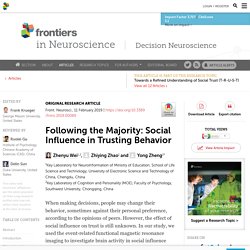

Individuals monitor the behaviour of those around them to determine how to act or behave in a correct and socially acceptable manner. Pluralistic Ignorance & Social Norms - iResearchNet. Pluralistic Ignorance Definition Pluralistic ignorance occurs when people erroneously infer that they feel differently from their peers, even though they are behaving similarly.

As one example, imagine the following scenario: You are sitting in a large lecture hall listening to an especially complicated lecture. After many minutes of incomprehensible material, the lecturer pauses and asks if there are any questions. No hands go up. You look around the room. Another case of pluralistic ignorance that is familiar to many college students concerns drinking on campus. Pluralistic Ignorance and Social Dynamics Pluralistic ignorance plays a role in many other dysfunctional social dynamics. Pluralistic Ignorance and Social Norms Pluralistic ignorance begins with widespread conformity to social norms—norms that govern appropriate behavior in the classroom, at a party, in a boardroom, or in a hospital; norms that regulate behavior with friends, strangers, or colleagues.
References: O’Gorman, H. Pluralistic Ignorance: The Bystander Effect and Altruism. Bystander effect. Bystander effect, the inhibiting influence of the presence of others on a person’s willingness to help someone in need.

Research has shown that, even in an emergency, a bystander is less likely to extend help when he or she is in the real or imagined presence of others than when he or she is alone. Moreover, the number of others is important, such that more bystanders leads to less assistance, although the impact of each additional bystander has a diminishing impact on helping. Investigations of the bystander effect in the 1960s and ’70s sparked a wealth of research on helping behaviour, which has expanded beyond emergency situations to include everyday forms of helping. By illuminating the power of situations to affect individuals’ perceptions, decisions, and behaviour, study of the bystander effect continues to influence the course of social psychological theory and research.
Bystander intervention Get exclusive access to content from our 1768 First Edition with your subscription. Simply Psychology. Social influence is the process by which an individual’s attitudes, beliefs or behavior are modified by the presence or action of others.

Four areas of social influence are conformity, compliance and obedience, and minority influence. Conformity / Majority Influence Conformity is a type of social influence defined as a change in belief or behavior in response to real or imagined social pressure. It is also known as majority influence. Compliance AO1 This refers to instances where a person may agree in public with a group of people, but the person privately disagrees with the group’s viewpoint or behavior.
For a study on compliance refer to Asch's Line Study. Internalisation AO1 Publicly changing behavior to fit in with the group while also agreeing with them privately. For a study on internalisation refer to Jenness (see below). Identification AO1 Identification occurs when someone conforms to the demands of a given social role in society.
A good example is Zimbardo's prison study. Group Size. Following the Majority: Social Influence in Trusting Behavior. Introduction Our opinions and behaviors are often affected by the majority (Asch, 1956; Turner, 1991).

People tend to change their opinions and behaviors in order to follow with social norms, even if the majority decision is against their personal preference (Cialdini and Goldstein, 2004; Morgan and Laland, 2012; Haun et al., 2013). Psychologists defined this phenomenon as “social conformity.” It refers to individuals’ action of adopting the opinions, behaviors, and judgments of others (Turner, 1991). Asch (1951) used a simple line judgment task to investigate social conformity. Recent studies have investigated the effect of conformity in many judgment tasks as well as the neural basis of conformity.
Firstly, we hypothesized that the choices of the majority would affect subjects’ trust preference. Materials and Methods Participants Twenty-seven healthy right-handed participants (mean age = 21.1, female = 16, male = 11) participated in the experiment.